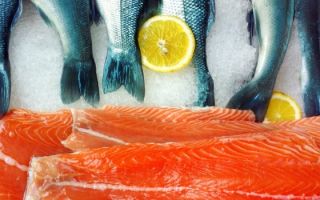Content
- 1 Description and types of salmon
- 2 Vitamins and minerals in salmon
- 3 Nutritional value and calorie content of salmon
- 4 The beneficial properties of salmon
- 5 Slimming salmon
- 6 At what age can salmon be given to children
- 7 Which salmon is healthier: farmed or wild
- 8 The benefits and harms of salmon caviar
- 9 Why salmon milk is good for you
- 10 The benefits and harms of smoked salmon
- 11 Is Canned Salmon Healthy
- 12 The benefits of salmon fat
- 13 Cooking salmon at home
- 14 Salmon harm and contraindications
- 15 How to choose and store salmon
- 16 Conclusion
- 17 Reviews
Red fish is one of the healthiest foods on the planet. Due to its wide distribution, everyone knows about its value. However, few people know that salmon can be hazardous to health. What are the benefits and harms of salmon: we will learn more about what this popular product hides in itself.
Description and types of salmon
Salmon is the collective name for several species of fish in the genus Salmoniformes. They live in the northern Atlantic and Pacific oceans and are anadromous. This means that most salmon species are born in fresh water, migrate to the sea and return to fresh water to breed or spawn.
The appearance of salmon varies greatly from species to species. Some fish are silvery blue, and some have black spots on the sides or bright red stripes. Most salmonids maintain one color when they live in fresh water and then change color when in salt water.
The following types of this fish are most often commercially mined:
- Chinook salmon (Oncorhynchus tschawytscha), also known as king salmon: considered one of the best species. This fish is high in fat and has a tender meat that ranges in color from white to dark red.
- Coho (Oncorhynchus kisutch) is sometimes called silver salmon because of its coloration: the fish has bright red meat and a slightly finer texture than chinook salmon (but similar flavor).
- Pink salmon (Oncorhynchus gorbusha) is the most common Pacific salmon, also called pink salmon. The fish has very light and aromatic meat. This type of salmon is low in fat. Pink salmon are often harvested for canning, but they can also be found on the market fresh, frozen and smoked.
- Red salmon (Oncorhynchus nerka), or red salmon, with bright red-orange flesh and rich aroma.
- Salmon (Salmo Salar) or Atlantic salmon. While several species of salmon live in the Pacific Ocean, only this one lives in the Atlantic. Currently, this species is bred on farms, because of which it has a not very good reputation.
- Chum (Oncorhynchus keta), or "dog" salmon, so named because of the unusual shape of the teeth. It is a small fish with pale pink flesh and lower fat content. It is usually canned or sold frozen.
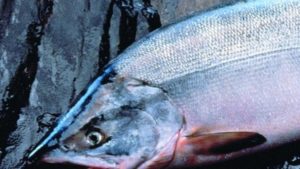
- Trout (Oncorhynchus S. Fario) is a freshwater fish from the genus salmonids. Usually small in size, sold fresh or smoked.
Vitamins and minerals in salmon
Salmon is one of the most nutritious foods around. This healthy, fatty fish is loaded with nutrients, so it can minimize risk factors for a number of diseases.In addition, it is tasty, versatile and widely available.
Salmon is one of the best sources of the omega-3 fatty acids EPA and DHA. Each serving of farmed salmon (one hundred grams) has 2.3 g of these compounds, a similar serving of wild salmon has 2.6 g.
Unlike other fats, omega-3 fats are known as "essential" fats, which means that everyone is encouraged to get them from the diet, since the body itself cannot create them.
DHA and EPA have been credited with several benefits to the body, such as reducing inflammation, lowering blood pressure, lowering the risk of cancer, and improving arterial cell function.
In addition, the benefits of salmon for humans are explained by the considerable level of B-vitamins. One hundred grams of the product contains the following amount:
- B1 (thiamine): 18% of the DV
- B2 (riboflavin): 29%;
- B3 (niacin): 50%;
- B5 (pantothenic acid): 19%;
- B6: 47%;
- B9 (folic acid): 7%;
- B12: 51%.
These vitamins are involved in several global processes in the body, including converting food eaten into energy, recreating and repairing DNA, and reducing inflammation that can lead to heart disease.
All B vitamins have been found to work together to support optimal brain and nervous system function.

Among other things, salmon are a good source of potassium. This is especially true for wild salmon, which provides 18% of the daily requirement per 100 grams. This mineral controls blood pressure levels, thereby reducing the risk of stroke. Therefore, the benefits of salmon are especially important for men over 50.
Fish has a high selenium content. This mineral has been shown to protect the health of the skeletal system, ameliorate thyroid disease and prevent cancer.
Salmon contains astaxanthin, a compound with significant health benefits. Since it is an antioxidant from the group of carotenoids, it is it that gives the fish a red hue.
Astaxanthin reduces the risk of heart disease by lowering LDL cholesterol (“bad”) and raising HDL (“good”). The substance is believed to have the ability to react with Omega-3s to protect the brain and nervous system.

Nutritional value and calorie content of salmon
Salmon is a protein product. Like Omega-3 fat, protein is an essential macronutrient that a person needs to get from their diet.
It plays an important role in the body, including helping to recover from injuries, protecting the skeletal system, and maintaining muscle mass during aging and weight loss.
Another property of fish is as follows. In addition, the tryptophan found in salmon is a source of seratonin, which may help cope with depression.
In addition, since this fish is an excellent source of vitamin D, eating it can also help improve mood, protect against macular degeneration, and aid in bone health.
One piece of salmon weighing 125 g contains 22 - 25 g of protein. The calorie content of a portion of this size will be 185 kcal, which is not much. This product contains 0.9 g of saturated fat, and 3.6 g of unsaturated compounds with healing properties. It does not contain carbohydrates. Therefore, the benefits of salmon for pregnant and lactating women are undeniable.
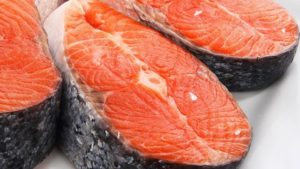
The beneficial properties of salmon
It is believed that eating fish twice a week is a great way to improve heart health. People who regularly eat this product are protected from the development of many conditions that can cause harm.Omega-3s reduce inflammation in the body. This process is at the root of many health problems, including diabetes, heart disease, certain types of cancer, and arthritis. Omega-3's properties can prevent blood clots, which can cause serious harm.
Some studies also show that healthy fats can help slow cognitive problems like Alzheimer's and age-related cognitive decline. In this regard, the benefits of salmon bellies, which contain the most fat, stand out.
For the heart and blood vessels
Eating salmon fish on a regular basis can protect against heart disease. This is due to the properties of salmon to increase the Omega-3 in the blood, which is able to balance the increased content of omega-6 fatty acids in the blood, which is characteristic of some people.
When the balance of the above two fatty acids is imbalanced, the risk of heart disease increases.
For the brain and nervous system
A growing body of research shows that including salmon in the diet can improve brain function. It reduces depressive symptoms, protects fetal brain health during pregnancy, reduces anxiety, slows memory loss with age, and reduces the risk of dementia. Breastfeeding salmon is recommended without fail due to the above properties.
For bones and joints
Bones are extremely important in the body - they provide body structure, protect organs and muscles, so it is important to take care of them. A balanced diet with enough calcium and vitamin D from salmon is a means of building the building blocks for healthy bones as we age. The properties of this product are simply exceptional.
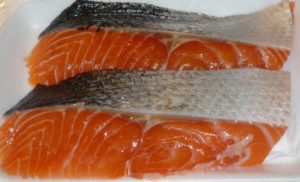
For sight
People who regularly consume Omega-3s have been shown to have a lower risk of developing macular diseases (retina). Because salmon is rich in these nutrients, its benefits for improving vision are invaluable.
For skin
With age, dark spots, wrinkles and freckles begin to appear on the skin. In fact, young women may have oily or dry skin that tends to be prone to breakouts or flaking. Salmon is highly recommended for improving skin health.
Omega-3, protein, and vitamin D help cells produce collagen, keratin and melanin. This beneficial property will help the skin retain water, thereby reducing wrinkles and blemishes. Astaxanthin helps to kill bacteria and toxic oxygen radicals and improve skin elasticity. These properties speak for the great benefits of salmon for women.
With diseases of the thyroid gland
The beneficial properties of salmon, as already noted, lie in the high content of Omega-3. Eating this fish has a direct link to thyroid health and due to its high iodine content. Not surprisingly, salmon is part of a balanced diet that benefits this condition.
For cancer prevention
Cancer can be caused by an imbalance between Omega-3 and Omega-6 in the body, resulting in toxic growth, inflammation, and uncontrolled cell proliferation. How can this harm be reduced?
Adding this fish to your diet can help increase levels of the first component, thereby reducing inflammation and toxins in your body. The benefits of salmonids have been shown to be useful for treating cancer and preventing its progression. They are also able to prevent chemo-induced muscle loss.
With diabetes
Getting enough healthy fats on a regular basis is especially important for diabetics who are at increased risk of heart disease and stroke.
DHA and EPA protect the cells that line up blood vessels, reduce markers of inflammation, and improve arterial function after meals. People who eat salmon regularly have a reduced risk of heart failure and are less likely to suffer from heart disease.
Fish is an excellent source of high quality protein that helps a person feel full. What's more, the beneficial properties of salmon fillets boost metabolism.
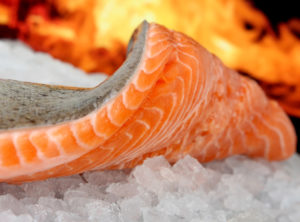
Slimming salmon
Consuming salmon can help you lose weight and keep it. Like other high-protein foods, they help regulate hormones that control appetite and make you feel full.
In addition, the properties of this fish are such that after eating it, the metabolic rate increases. Fatty acids can promote weight loss and reduce belly fat in overweight people.
In addition, salmon is very low in calories. A 125-gram serving of salmon has only 206 calories, while less fatty species have even less at 182 calories.
At what age can salmon be given to children
Researchers have found that DHA and EPA fatty acids, in certain combinations, can help reduce ADHD (attention deficit hyperactivity disorder) symptoms in children. This combination has also been found to be beneficial for children with autism and dyslexia. Every nursing mother needs salmon, as its properties are amazing.
The harm of this fish to a child can be caused exclusively by an allergic reaction. If there are no such manifestations, you can safely make it a regular part of the children's diet. The medical recommendation states that two servings of fish per week are beneficial for a child. For children aged one to two years, this is 30 - 40 g of the product, 50 g - for the age of three to six years, 70 g - for a child over six years old.
It is believed that potential harm from fish may come from the mercury content in it. However, salmon are considered safe in this regard.
Which salmon is healthier: farmed or wild
A healthy diet includes two to three servings of fatty fish per week. Salmon is perhaps one of its most popular varieties. It does not have a strong fishy odor or pungent taste, is readily available and can be prepared in a variety of ways.
But in recent years, it has been advised to choose wild salmon instead of farmed salmon to get all the benefits and properties. There are several reasons for this.
First, farmed salmon live on an artificial diet. Some farms feed fish with foods that cannot be found in the ocean: fishmeal and fat, chicken, grains and vegetable protein (most often soy). The result is meat that contains more calories and unhealthy omega-6 fatty acids that can be harmful.
The farmer's variety also contains more than double the amount of fat, including saturated fat. However, both species have nearly equal amounts of protein and cholesterol. Selenium levels are also twice as high in wild salmon compared to farmed. There are benefits from consuming such salmon, but it is better to choose wild species with the best set of properties.
Farmed fish can also be toxic and potentially harmful. For example, commercially available cooked steaks are sometimes contaminated with polychlorinated biphenyls (PCBs).
The benefits and harms of salmon caviar
Salmon caviar is not just a wonderful delicacy. It also has some outstanding health benefits and properties. So, one tablespoon of caviar contains more than 1 gram of healthy unsaturated fats.

In addition, it is also an excellent source of vitamin B12, which is responsible for making red blood cells and helps the body use fatty acids. Selenium, the benefits of which are undeniable, is also found in caviar. It works as an antioxidant along with vitamin E to protect cells from damage caused by free radicals and other compounds in the body that can lead to heart disease or cancer.
Caviar is also rich in vitamins A and E, which are essential for cell growth and a healthy immune system. A tablespoon of caviar contains about one tenth of the daily value of these compounds.
Salmon roe is also high in protein and low in trans fats and carbohydrates, which are harmful if overused. This delicacy is also rich in potassium, which lowers blood pressure. Potassium is also thought to help prevent the buildup of kidney stones, and some migraine sufferers find it to help relieve symptoms.
The harm to salmon caviar may lie in the fact that it has high cholesterol levels. The sodium content of the product is another disadvantage. The caviar is soaked in a saline solution during processing, which leads to an increase in the content of this substance. The properties of this product are identical to those of salted fish. The benefits of such salmon are not disputed, but excess salt reduces it somewhat.
Why salmon milk is good for you
Salmon milk can be beneficial to the body due to its high protein and healthy fat content. Their properties are similar to those of the fish itself. You can cook them in a variety of ways: fry and use as a filling in pies, pancakes, and so on. The only harm to this product is associated with a possible allergic reaction.

The benefits and harms of smoked salmon
Smoked salmon has both beneficial and harmful properties. Like fresh, it is a good source of protein, vitamins B and D, magnesium and selenium. Large amounts of DHA and EPA have been shown to help reduce the risk of heart disease, prevent macular degeneration and Alzheimer's.
Smoked salmon, on the other hand, is high in sodium. For example, 120 g of a product contains 666 mg of sodium, which is more than one third of the daily value.
Before smoked fish, it is processed by adding salt in the form of brine (a mixture of salt, water and spices) or its crystals. Salt reduces the moisture content of salmon, which helps to extend its shelf life. It also helps prevent the growth of germs that can cause food poisoning.
Most smoked salmon are cold smoked, meaning they are cooked at a temperature that is not high enough to kill potentially harmful bacteria. Therefore, it is possible harm from Listeria monocytogenes, bacteria that can cause rare but serious food poisoning, especially among pregnant women, the elderly, and people with weakened immune systems.
Hot smoked salmon is lighter in color and looser. It is processed at a temperature of about 80 ° C and is completely ready for use. Despite the heat treatment, it can also be harmful if technological processes are disrupted.

There is also concern that eating smoked foods may increase the risk of cancer. Smoked salmon contains nitrates and nitrites, by-products of smoking. Their harm lies in the fact that they can be converted in the body into N-nitroso compounds, which are carcinogenic. Thus, there are both benefits and harms of smoked salmon for the body.
Is Canned Salmon Healthy
Canned salmon is rich in protein, vitamin D, calcium (from bones), and healthy omega-3 fats. Therefore, its benefits seem obvious. The ideal serving of these canned foods is 75 g, or half a cup (125 ml).
All types of canned salmon (pink salmon, coho salmon and sockeye salmon) are healthy choices. It is better to purchase canned food with bones to get the most calcium.The harm may lie in the increased sodium content, so it is best to look for the least salty product.
The benefits of salmon fat
Primarily, the benefits of salmon fish oil lie in its ability to reduce inflammation. This is a very dangerous process. It can cause weight gain, joint pain, autoimmune conditions, stomach ulcers, and stroke. The omega-3 fatty acids found in salmon oil regulate the hormones responsible for this. The latter, in turn, activate cellular pathways, gene expression, and anti-inflammatory biomolecules that prevent migraines, arthritis, psoriasis, ulcerative colitis, multiple sclerosis, Crohn's disease, inflammation-induced obesity, etc.

The benefits of salmon fish oil are also in the fact that it improves skin health, promotes hair growth and prevents hair loss, providing nutrition to the follicles.
Cooking salmon at home
Salmon has healthy and tasty meat that is easy to cook. It is delicious baked, pan-fried or grilled, added to salads and pies, and so on. To reap the maximum health benefits and reduce harm from salmon, it is advisable to use non-fat cooking methods.
Salmon in a creamy sauce
Most salmon recipes suggest eating it with the skin. But to get the most out of the product, it's best not to consume it. To make salmon in a creamy sauce really tasty, you need to use heavy heavy cream.
One of these recipes requires:
- 3 tbsp. l. lemon juice;
- 1/4 cup chicken or fish broth, white wine, or water
- 2/3 cup heavy cream
- 1 tbsp. l. frying oils;
- salt;
- freshly ground black pepper;
- 700 g salmon fillet;
- parsley for garnish.
Sequencing:
- Make lemon cream sauce. To do this, pour the lemon juice, broth and cream into a small saucepan and bring to a boil.
- Reduce temperature to low, cover saucepan and cook gently for 10 minutes, adding salt and pepper.
- At the last minute or two, open the pot and increase the cooking temperature to thicken the sauce a little.
- While the sauce is cooking, rinse the salmon in cold water and pat dry with paper towels.
- Pour oil into a saucepan, heat it over high heat for 90 seconds.
- Then fillet is laid out in a saucepan.
- Fry it for 3 - 5 minutes, depending on the thickness of the fish. Fillet 3 cm thick will cook for about 5 minutes.
- Using a metal spatula, turn and cook for another 1 to 5 minutes.
The finished salmon fillet is laid out in a deep plate and poured with hot sauce. Sprinkle with chopped parsley on top to garnish.
Salted salmon
For salting, raw fish is placed in a mixture of salt and sugar. The process continues for 4 days in the refrigerator, after which the lightly salted salmon is thinly sliced and eaten cold.
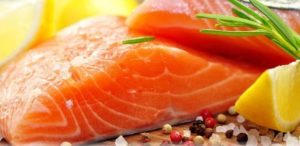
Usually served as a snack, it is also great for sandwiches or as a main course. Salted salmon tastes similar to smoked salmon, but has a firmer texture. In addition, this method of cooking is much less harmful and more beneficial, since the processing of lightly salted salmon is minimal.
For a salmon salting recipe you will need:
- salmon fillet - 500 g;
- 2 tbsp. l. salt;
- 2 tsp Sahara.
If the salmon fillet is thicker than 1.5 cm, it is best to cut it into 2 layers.
Salmon is placed in a glass dish, sugar and salt are rubbed into it from all sides.
The container is closed with a lid, placed in the refrigerator and left to salt for 4 days, after which the salted salmon can be eaten.
Salmon harm and contraindications
Salmon can be harmful because it contains purines, which can exacerbate gout attacks. Therefore, if you have this disease, you should not eat fish.
Another possible harm to the body can bring possible allergic reactions.
There is controversy over the health benefits of raw salmon. Does it have harmful properties? In fact, it is not harmful when consumed fresh and certified from a trusted source.
How to choose and store salmon
If you want to purchase wild salmon, you should choose Pacific salmon. This is because the commercially available Atlantic species is in almost all cases farmed.
Fresh salmon should never smell like fish. The meat should be bright and moist, not discolored around the edges. When buying a whole salmon, pay attention to the following: the eyes should be bright and clear, the skin should be silvery, shiny and firm to the touch.
Raw fish is best eaten immediately after purchase. Otherwise, the benefits of raw salmon will disappear.
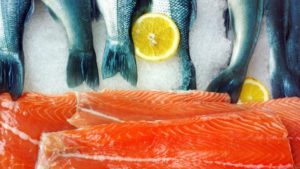
You can store chilled fish in the refrigerator for two days.
There is a way to keep the fish in a pot of ice. To do this, place the fish on a layer of crushed ice in a saucepan and cover with a second layer of ice. Add ice as needed.
Whole fish carcasses, as well as fillets and steaks, perfectly retain their qualities in the freezer for up to three months.
Conclusion
Knowing what the benefits and harms of salmon are, the following conclusions can be drawn. This fish is a nutritious food that has several impressive human properties.
Consuming at least two servings weekly will help meet the body's needs for nutrients and reduce the risk of developing heart disease, cancer and several other diseases.
Among other things, salmon are easy to prepare and delicious. Adding to a regular diet can significantly improve quality of life.

